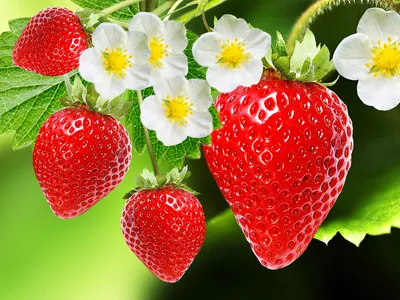Angela Lassam
Growing Strawberries and other soft fruit
When you are deciding what to do in your vegetable garden consider trying to incorporate some soft fruit. If you do not have any garden but would like to have fresh home-grown fruit this summer plant up a pot or container to enjoy. It is easy to grow most of the common fruit we use in smoothies, fruit salad even garnish for a salad.
Strawberries are the most favoured fruit all over the world and always available but they are the easiest of fruits to grow and when in season are sweeter, fresh and easy to acquire or pick your own locally. You only need to buy a few plants the first season. One plant can increase to several within the first year. They can be purchased either as a potted plant to go directly in the soil or as a bare root with just a compact crown. ‘Albion’ is a good versatile everbearing type, hardy to zone 2.
Before planting the bare root stock you will need to place them in water for a few hours. Plant them 1ft apart and at least 2ft between the rows to form a strawberry bed keeping the crown above the soil. They need at least 6 hours of sunlight. Apply a slow release fertilizer and top dress with straw to protect the roots and help prevent mold forming. They need daily watering. Do not plant where you have had verticillium wilt or fusilarium which is common on tomatoes. After fruiting each plant will put out runners and will root to make new plants. They can be left between the old ones or nipped off and replanted to make the strawberry bed larger.
The strawberry is not a true fruit as its seeds are on the fleshy outer membrane- the yellow seeds, as many as 200 on a single fruit. The fruit is high in vitamin C and manganese and 90% water. It is the protein creating the red colour that causes allergens; specifically hay fever, hives and in some cases dermatitis.
Raspberries are one of the fruits often used in smoothies but best when eaten as a dessert or snack. As with strawberries they are easy to grow and sweetest when fresh picked in season. A few plants will produce a good yield and multiply quickly. They look like green sticks called canes.
They can be found potted up ready to plant or as bare roots. As soon as last frost has passed find a location protected from winds and where they can be supported. Soak the bare roots a few hours before planting. They need to be 18” apart allowing for extra canes to form. As they grow they will need supporting with a trellis or wire, they can grow up to 5’. They like compost dressing and watering frequently. After they have finished fruiting they need the fruit canes pruned to the ground. Leave any new canes for next year and any suckers can be cut out and replanted for next year increasing your raspberry patch. Everbearing are the easier canes to buy as they fruit first year and need to be pruned completely at year end. Heirlooms fruit on second year canes and you need to prune out only those that have fruited.
The raspberry is a perennial of the buckwheat family, hardy to zone 3. It is the same as the strawberry, not a true fruit as it has its seeds in the drupelets – the fleshy part of the fruit which numbers over 100 per fruit. The other difference is it leaves the core on the stem. The raspberry is usually pest free but look out for the Japanese beetle and spider mites.
Interesting note – both these fruits are on the top of a list in California called “Dirty Dozen” for the highest pesticide contamination.
Growing your own fruit is the best way we can be sure we can enjoy its freshness and is good for our health and well being.
The next meeting for the Tillsonburg Horticultural Society is on Tuesday May 2nd 7.30pm in the Senior Centre Tillsonburg Community Centre. The topic is ‘New hostas for 2023’ with Shirley Kosh, Riverbend Gardens & Nursery. Bring cash, plants for sale. Social time. Guest $4 or $20 annual membership. More information www.tillsonburghorticultural.ca or Facebook-Tillsonburghorticultural. Everyone welcome.








